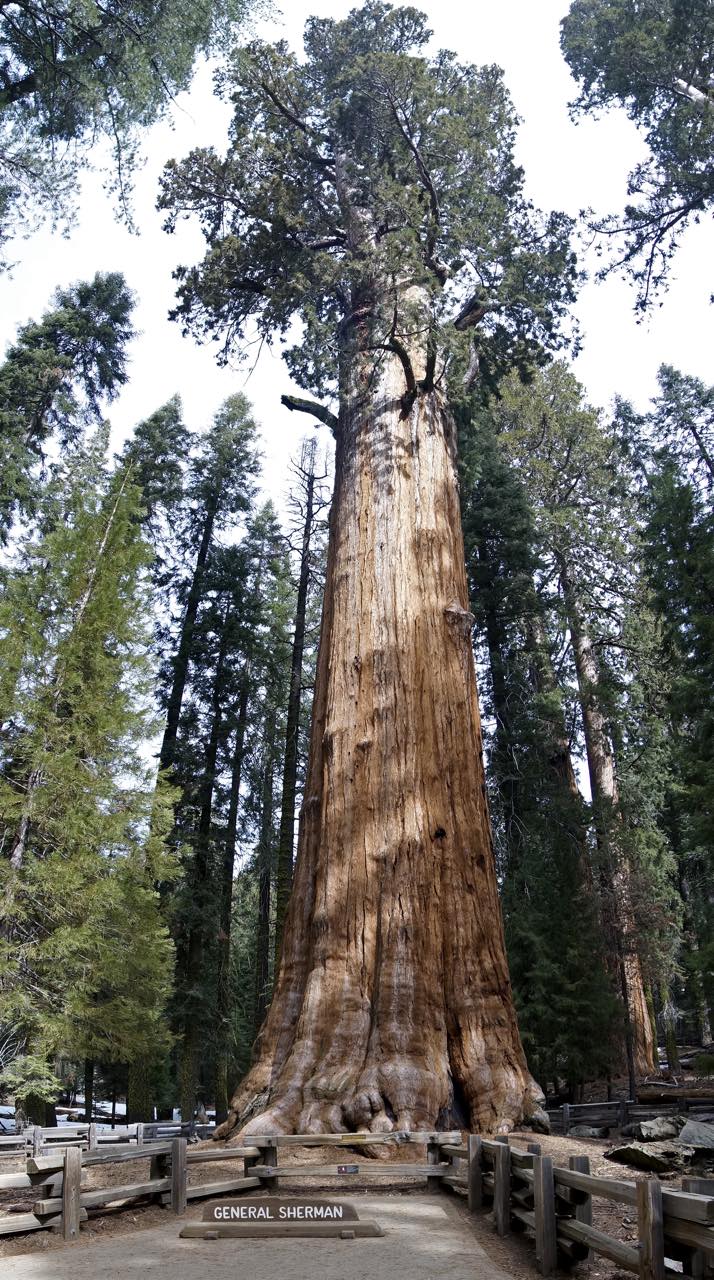California’s immense size isn’t the only thing that makes visiting its natural treasures so difficult. Anyone who has been following my path down the west coast can only describe my route south as serpentine. When I envisioned travelling through California, I spent hours trying to figure out my most efficient route south that would still allow me to see all that California has to offer. In short, that route doesn’t exist. From north to south, California’s natural wealth begins on the coast and stretches all the way towards its eastern border. My journey south, therefore, requires hundreds (if not thousands) of miles of lateral travel. My zigzagging from coastal beaches, through expansive plains, up into mountainous forests has introduced me to many different sides of California. The diversity is inescapable.
After leaving Yosemite behind, I headed south to visit a new element of California’s epic biodiversity: the giant sequoia groves. Although Kings Canyon and Sequoia National Parks don’t necessarily register for many American’s as must-see natural areas, they hold treasures that we should all be proud of. I will admit, however, that both winter road closures and my sickly demeanor didn’t leave me feeling very adventurous. I did my best though!


Normally, the General’s highway connects Kings Canyon National Park in the north to Sequoia National Park in the south, which is why the two parks are so often spoken of symbiotically. In the winter, snow and ice make that road impassable. Coming down from Yosemite, I hit Kings Canyon first, hopping out at the visitor’s center before preparing for some quick hikes. I didn’t have the energy or the desire to head into the backcountry, so I limited my exploration to the network of short hikes running through the groves of sequoias. My first stop was the General Grant Grove of giant sequoias. Originally set aside as a General Grant National Park in 1890, this grove is home to the second largest tree in the world: the General Grant Tree. With a circumference of 107 feet and a height of 267 feet, this 1,650 year old tree challenges the imagination in many ways. The redwoods of northern California may be taller, but I had never seen anything as massive as these sequoias. They are absolutely immense!

Moving on from the trees, I headed out to drive as far along the General’s highway as possible. The road was clear until the Kings Canyon overlook, which offered unparalleled views of the Sierra Nevada’s and Mount Whitney, the tallest mountain in the continental US. On the recommendation of the ranger, I decided to head out with the sun high in the sky, making my way for route 245, a windy route leading through a lush valley just beneath the ridges of Kings Canyon and Sequoia National Parks. The setting sun highlighted the deep emerald of the grassy valley and refracted brilliantly off of low patches of rusty undergrowth. Alone on the road, I relaxed into the banking turns and sharp curves that followed the contours of the land. As dusk transitioned to night, I turned off onto a bouncy gravel road leading deep into the South Fork River valley. With steep drop-offs and deep ruts, I crawled slowly into the depths of the valley, eventually finding my campground high above the rushing river just within the borders of Sequoia National Park.



My remote campsite, however, did not provide direct access to the park, so I had to retrace my steps in the morning light. In reverse, the drive seemed so short! The unknown of driving a road or hiking a trail for the first time really does mess with your brain… Before I knew it, I was back in Three Rivers and headed down the main road into Sequoia National Park. Beginning at the valley floor, the road into Sequoia winds up steep slopes and around rocky intrusions until you find yourself nestled among the gigantic trunks and high canopy of the sequoia groves. Here, I found the General Sherman tree, the largest tree on the planet. Almost a thousand years older than the General Grant tree, General Sherman has a slightly smaller circumference (102 ft), but soars to a height of 275 feet. There are few living things that necessitate vertical panoramas to capture their size, but these sequoias easily require such a neck craning activity. After checking the tree off my list, I wandered around for the next few hours, hiking to overlooks, checking out sequoia stumps, and strolling through hollowed out logs. Not wanting to camp in the park, I ended up driving off into the sunset towards the coast once more.




Everything in Kings Canyon and Sequoia National Parks feels like it is on a different scale. The trees are gargantuan, the jagged peaks of the High Sierra scrape the sky, and the forested canyons stretch for miles. It is an epic landscape. It is yet another park that I will return to in the warmer months to more fully explore its treasures. Both parks, at least for me, also stand out for another reason. I have visited many National Parks at this point and have been struck by the diversity of the natural wonders that we have protected. I have not, however, been very impressed by the diversity of the people exploring those wonders. In my experience, America’s National Parks are an incredibly homogenous. Kings Canyon and Sequoia, however, broke that mold. For the first time, being a white male traveling through the park landed me squarely in the minority.
Exploring the racial and cultural associations to the National Parks or to “wilderness” is an essential component in bettering my understanding of American relationships to the land that we have chosen to protect. I do not pretend to have all of the answers, but Kings Canyon and Sequoia served as a poignant reminder that everyone has a different association with “wilderness” and that those associations are worth exploring. That will be an exposé for another time though.
Map Time!



3 Responses
susan fey
JBoy, your green valley pic is a stunner. We are just back from a week in SF, and were gaping, the whole time, at the GREEN. Well, what we could see of it from under our umbrellas, that is. You are seeing a greener California than is common lately. Safe travels! Hope you are healthy again.
Mary Kelly
Terry and I lived in the Sierra Nevada Mountains at a place called Shaver Lake which is located
about 35 air miles NE from Fresno. He ran a cloud seeding project for 2 winters before
we moved back to Madison. Beautiful place.
Mary
jcronon
That sounds like a prime location! Although your spot in Madison isn’t too bad either 🙂